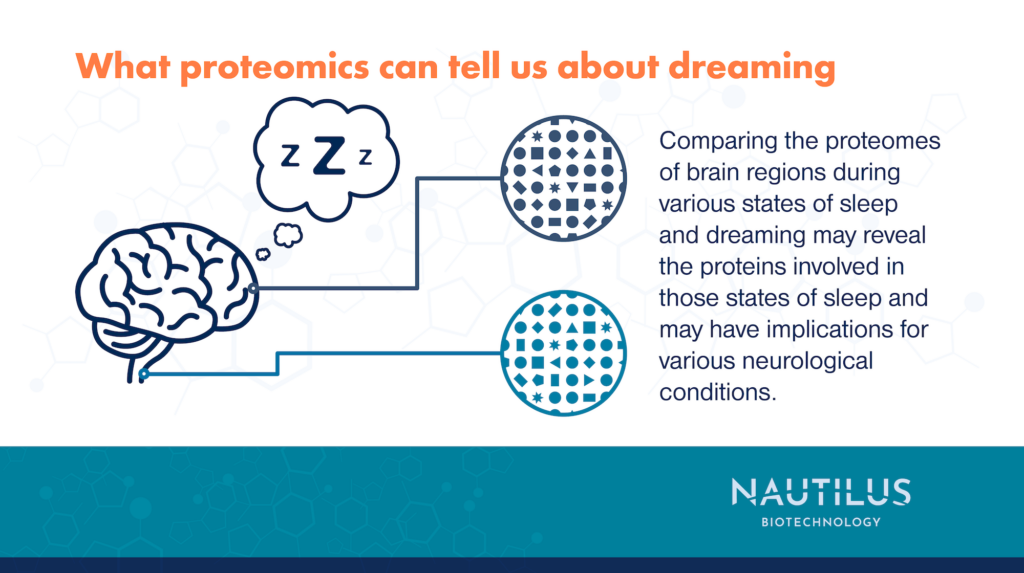
We spend approximately one third of our lives sleeping. That is around 9 thousand days and over 200 thousand hours. For something humans dedicate 8 hours to every night, there is surprisingly little known about a prominent side effect of deep sleep – dreaming. What causes our brain to concoct wild adventures or frightening nightmares during our resting hours? Is there a difference in the molecular innerworkings of the brain when we imagine an outlandish escapade with friends versus being chased by a faceless monster? In this post, we will imagine some of the ways that a comprehensive look into the proteome, the collection of all proteins in a cell or other biological entity, can reveal insights into why or even how we dream.
What DO we know about dreaming?
Much like dark matter and the deepest depths of the ocean, the mechanics of dreaming have consistently eluded humans. Are dreams an indicator of our brain chemistry? Our emotional or mental state? Our future? What is known about dreaming is that it primarily occurs during rapid eye movement, or REM, sleep. During this period, brain activity resembles that of an awake brain despite being in a state of deep sleep (See Peever and Fuller 2016 for a review of REM sleep biology). The molecular mechanisms underlying REM sleep still remain a bit of a mystery.
Studies have uncovered a potentially key player in REM sleep, even if the exact role is still unclear. Acetylcholine, a neurotransmitter found throughout the brain and body, and its corresponding receptors seem to contribute to the progression into REM sleep. Past studies found acetylcholine release to be abundant in the brainstem during REM sleep and specific acetylcholine receptor gene knockouts abolished the ability to achieve REM sleep (see Yamada and Ueda 2020 for a thorough review). Acetylcholine’s precise function has continually baffled researchers as have the other players involved in REM sleep.
Revealing the molecular mechanisms behind dreams through proteomics
To fully understand the innerworkings of our brains at night, we must first have a better understanding of acetylcholine’s role in the mechanisms behind REM sleep and identify the other molecules responsible. That is where an enhanced understanding of proteomics could come into play. Analyzing the human proteome at various stages of sleep can reveal proteins present in higher abundance during periods of REM sleep. On the flip side, sensitive proteomics analysis has the potential to detect low abundance proteins and proteoforms unique to REM sleep. These proteins may be involved in the machinery underlying characteristic aspects of this phase. Additionally, more robust experiments can be performed to analyze how the presence of critical proteins activates or inhibits specific cell types and the various products these cells release. Finding more pieces of the molecular puzzle is a crucial step towards achieving greater understanding of REM sleep.
Within REM sleep, what actually triggers periods of dreaming is still under debate. A study by Mark Solms found that the brainstem was responsible for the induction of REM sleep, while the forebrain gave rise to the actual dreams. This suggests that although REM sleep and dreams often go hand in hand, they may have unique components and mechanisms. Proteomics analyses of circulating proteins within different brain regions can further assess the presence of specific proteins, pathways, and alterations of downstream molecules – uncovering ways in which molecules and mechanisms activate this dreaming state and where they occur in the brain. This in-depth analysis has the potential to further differentiate the factors involved in stimulating a good dream versus a nightmare. While it may be some time before researchers can probe the human brain proteome without disrupting a good night’s sleep, a comprehensive proteomics analysis can – for the time being – extract valuable information from dreaming model systems such as other mammals, birds, or even octopi.
A fundamental question surrounding this area of research is why we dream in the first place. Current theories suggest that dreams are a means of consolidating and analyzing memories. Understanding which molecules are involved, where they are produced, which cells they interact with, and what these cells produce could go a long way towards putting this mystery to bed.
Benefits tied to uncovering the machinery behind REM sleep (and dreams)
Those of us who religiously maintain a dream journal as a means of tapping into our subconscious may be onto something. Dreams – what they mean and how they occur – may have tangible benefits for human health. Understanding how we achieve this state of vivid imagination can also uncover insights regarding REM-related disorders or even ways to avoid unsettling dreams.
In fact, studies have suggested a wide range of REM sleep related benefits – improved ability to assess facial expressions and reduced fear related responses to traumatic events. Several disorders, in particular mood disorders, are linked to unusual REM sleep patterns. Pathogenically increased REM sleep is often seen in depression, and distressing dreams during REM sleep are characteristic of PTSD. Insights into REM sleep and dream associated mechanisms and molecules provided by a sensitive single-molecule proteomic analysis may simultaneously improve our understanding of our own brains, reveal possible therapeutic targets for mood disorders, and solve a mystery that has plagued humans for centuries.
MORE ARTICLES


